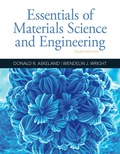
(a)
Interpretation:
The reason for which the aluminium is used for airplane bodies is to be explained.
Concept Introduction:
Aluminum is soft, non-magnetic and ductile metal which also forms an alloy by melting with copper silicon.
(b)
Interpretation:
The reason for polyurethane to be used for alignment of teeth is to be explained.
Concept Introduction:
Polyurethane is a polymer made up of organic units by combining units of urethane. The polyurethane is a thermosetting polymer which does not melt on heating.
(c)
Interpretation:
The properties of steel making it useful for ball bearing in the bicycles wheel hub are to be explained.
Concept Introduction:
Steel is one of the important engineering and construction materials. It is an alloy of iron and carbon where, carbon is less than 1%.
(d)
Interpretation:
The reason behind using polyurethane terephthalate for water bottles is to be explained.
Concept Introduction:
Polyurethane terephthalate is the most common thermoplastic polymer used in containers for liquids and foods. It is strong, lightweight plastic used in storage containers for foods and beverages, soft drinks, water, etc.
(e)
Interpretation:
The reason for the wine bottles to be made up of glass is to be explained.
Concept Introduction:
Glass bottles are chemical free, hence, there is no chemical leeching. They are easy to clean. Glass does not react with any other substance.
Trending nowThis is a popular solution!

Chapter 1 Solutions
Essentials Of Materials Science And Engineering
- (◉ Home - my.uah.edu Homework#5 MasteringEngineering Mastering X + 8 https://session.engineering-mastering.pearson.com/myct/itemView?offset=next&assignmentProblemID=18992146arrow_forward(read image)arrow_forward(◉ Home - my.uah.edu Homework#5 MasteringEngineering Mastering X + 8 https://session.engineering-mastering.pearson.com/myct/itemView?assignmentProblemID=18992147&offset=nextarrow_forward(◉ Home - my.uah.eduarrow_forward(read image)arrow_forward(◉ Home - my.uah.edu Homework#5 MasteringEngineering Mastering X + 8 https://session.engineering-mastering.pearson.com/myct/itemView?assignmentProblemID=18992148&offset=nextarrow_forward① Esterfication + R'on R Hydrolysis OH Alcohol A. 0-R Carboxylic Acid Ester NOD-10arrow_forward(◉ Home - my.uah.edu Homework#5 MasteringEngineering Mastering X + 8 https://session.engineering-mastering.pearson.com/myct/itemView?assignmentProblemID=18992144&offset=nextarrow_forwardA4.3- Design a square short column for P₁ = 1800 kN, Mfx = 250 kN.m, Mfy: f your final design p has to be between 0.01 and 0.02. = 50 kN.m. In Given: f'c = 25 MPa fy = 400 MPa Longitudinal bars: Use 25M Ties: 10M@ 300 Clear cover to the ties: 40mmarrow_forwardarrow_back_iosSEE MORE QUESTIONSarrow_forward_iosRecommended textbooks for you
 MATLAB: An Introduction with ApplicationsEngineeringISBN:9781119256830Author:Amos GilatPublisher:John Wiley & Sons Inc
MATLAB: An Introduction with ApplicationsEngineeringISBN:9781119256830Author:Amos GilatPublisher:John Wiley & Sons Inc Essentials Of Materials Science And EngineeringEngineeringISBN:9781337385497Author:WRIGHT, Wendelin J.Publisher:Cengage,
Essentials Of Materials Science And EngineeringEngineeringISBN:9781337385497Author:WRIGHT, Wendelin J.Publisher:Cengage, Industrial Motor ControlEngineeringISBN:9781133691808Author:Stephen HermanPublisher:Cengage Learning
Industrial Motor ControlEngineeringISBN:9781133691808Author:Stephen HermanPublisher:Cengage Learning Basics Of Engineering EconomyEngineeringISBN:9780073376356Author:Leland Blank, Anthony TarquinPublisher:MCGRAW-HILL HIGHER EDUCATION
Basics Of Engineering EconomyEngineeringISBN:9780073376356Author:Leland Blank, Anthony TarquinPublisher:MCGRAW-HILL HIGHER EDUCATION Structural Steel Design (6th Edition)EngineeringISBN:9780134589657Author:Jack C. McCormac, Stephen F. CsernakPublisher:PEARSON
Structural Steel Design (6th Edition)EngineeringISBN:9780134589657Author:Jack C. McCormac, Stephen F. CsernakPublisher:PEARSON Fundamentals of Materials Science and Engineering...EngineeringISBN:9781119175483Author:William D. Callister Jr., David G. RethwischPublisher:WILEY
Fundamentals of Materials Science and Engineering...EngineeringISBN:9781119175483Author:William D. Callister Jr., David G. RethwischPublisher:WILEY
 MATLAB: An Introduction with ApplicationsEngineeringISBN:9781119256830Author:Amos GilatPublisher:John Wiley & Sons Inc
MATLAB: An Introduction with ApplicationsEngineeringISBN:9781119256830Author:Amos GilatPublisher:John Wiley & Sons Inc Essentials Of Materials Science And EngineeringEngineeringISBN:9781337385497Author:WRIGHT, Wendelin J.Publisher:Cengage,
Essentials Of Materials Science And EngineeringEngineeringISBN:9781337385497Author:WRIGHT, Wendelin J.Publisher:Cengage, Industrial Motor ControlEngineeringISBN:9781133691808Author:Stephen HermanPublisher:Cengage Learning
Industrial Motor ControlEngineeringISBN:9781133691808Author:Stephen HermanPublisher:Cengage Learning Basics Of Engineering EconomyEngineeringISBN:9780073376356Author:Leland Blank, Anthony TarquinPublisher:MCGRAW-HILL HIGHER EDUCATION
Basics Of Engineering EconomyEngineeringISBN:9780073376356Author:Leland Blank, Anthony TarquinPublisher:MCGRAW-HILL HIGHER EDUCATION Structural Steel Design (6th Edition)EngineeringISBN:9780134589657Author:Jack C. McCormac, Stephen F. CsernakPublisher:PEARSON
Structural Steel Design (6th Edition)EngineeringISBN:9780134589657Author:Jack C. McCormac, Stephen F. CsernakPublisher:PEARSON Fundamentals of Materials Science and Engineering...EngineeringISBN:9781119175483Author:William D. Callister Jr., David G. RethwischPublisher:WILEY
Fundamentals of Materials Science and Engineering...EngineeringISBN:9781119175483Author:William D. Callister Jr., David G. RethwischPublisher:WILEY